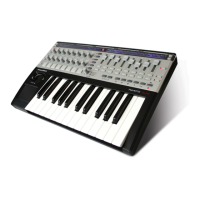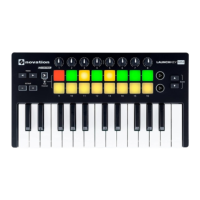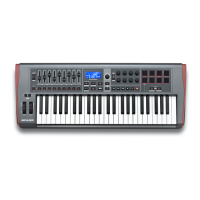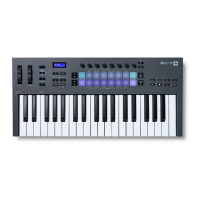the arpeggIator
The UltraNova has a powerful Arpeggiator feature which allows arpeggios of varying
complexity and rhythm to be played. If a single key is pressed, the note will be retriggered
by the Arpeggiator. If you play a chord, the Arpeggiator identifies its notes and plays them
individually in sequence (this is termed an arpeggio pattern or “arp sequence”); thus if you
play a C major triad, the selected notes will be C, E and G.
Arpeggiator operation in the UltraNova is controlled by the three ARP buttons [20], ON,
SETTINGS and LATCH. The ON button enables or disables the Arpeggiator, while the
LATCH button plays the currently selected arp sequence repeatedly without the keys being
held. LATCH can also be pressed before the Arpeggiator is enabled. When the Arpeggia-
tor is enabled, the UltraNova will immediately play the arp sequence defined by the last set
of notes played, and will do so indefinitely.
Editing of all Arpeggiator functions is carried out in the Arpeggiator Menu, which is opened
by pressing the SETTINGS button.
RE1: Arpeggiator Rate Sync
Displayed as: ArpSync
Initial value: 16th
Range of adjustment: see table at page 40
This parameter effectively determines the beat of the arp sequence, based on the tempo
rate set by RE8.
RE2: Arpeggiator Mode
Displayed as: ArpMode
Initial value: Up
Range of adjustment: see table at page 44
When enabled, the Arpeggiator will play all notes held down in a sequence which is deter-
mined by the ArpMode parameter. The third column of the table describes the nature of
the sequence in each case.
RE3: Arpeggiator Pattern
Displayed as: ArpPatt
Initial value: 1
Range of adjustment: 1 to 33
As well as being able to set the basic timing and mode of the arp sequence (with RE1 and
RE2), you can also introduce further rhythmic variations with the Arpeggiator Pattern
parameter.
You should spend some time experimenting with different combinations of Arp
Mode and Arp Pattern. Some patterns work better in certain Modes.
RE4: Arpeggiator Gate Time
Displayed as: ArpGTime
Initial value: 64
Range of adjustment: 1 to 127
This parameter sets the basic duration of the notes played by the Arpeggiator (though this
will be further amended by both the ArpPatt and ArpSync settings). The lower the param-
eter value, the shorter the duration of the note played. At its maximum value, one note in the
sequence is immediately followed by the next without a gap. At the default value of 64, the
note duration is exactly half the beat interval (as set by RE8 Tempo Clock), and each note
is followed by a rest of equal length.
RE5: Arpeggiator Octaves
Displayed as: ArpOctve
Initial value: 1
Range of adjustment: 1 to 8
This setting adds upper octaves to the arp sequence. If ArpOctve is set to 2, the sequence
is played as normal, then immediately played again an octave higher. Higher values of Ar-
pOctve extend this process by adding additional higher octaves. ArpOctve values greater
than 1 have the effect of doubling, tripling, etc., the length of the sequence. The additional
notes added duplicate the complete original sequence, but octave-shifted. Thus a four-note
sequence played with ArpOctve set to 1, will consist of eight notes when ArpOctve is set
to 2.
Tweak Menu Page 2:
Each encoder may have any of the available parameters (see list at page 42) assigned to it
for adjustment. Any Tweak Control assignments which form part of a fcatory Patch will be
displayed.
Tweak Menu Page 1:
When a parameter is been assigned to a rotary encoder – either as part of the Patch or
via manual assignment - the upper row shows the parameter name and the lower row the
parameter value, just as they are displayed in their “native” menu.
Note that Tweak and Touch modes are mutually exclusive – the encoders cannot be
assigned to both functions simultaneously, either globally or individually.
Touched/Filter Knob
The large TOUCHED/FILTER knob [9] is a further very useful control in live performance,
particularly if TOUCH or TWEAK functions are being used. It is used in conjunction with
the adjacent buttons FILTER and LOCK [8].
The knob’s function is to mimic that of the last-touched rotary encoder (this includes
Tweak mode). This continues to apply even when the currently-open menu or menu page
is changed. Thus if you have the Mix Menu open, and are using RE6 to vary Noise Level,
you will find that you can also vary Noise Level with the Touched/Filter knob. But if you
change to the Filter Menu, the Touched/Filter knob will assume control of Filter 1 Distor-
tion Amount (assuming the Filter Menu opens at Page 1) without any of the rotary encoders
being touched, because it remains assigned to mimic RE6. Think of Touched/Filter as
a “copy” of the last-touched rotary encoder when you are in parameter adjustment mode,
using the menus as normal.
If you are using either Tweak or Touch modes, then the rotary encoders are no longer avail-
able to control any sound parameters in the ‘normal’ way, but you can still control the last
parameter adjusted with the Touched/Filter knob. This functionality is always available, as
long as both FILTER and LOCK functions [8] are not enabled.
The Filter button
The parameter most often needed for dynamic adjustment is probably Filter 1 frequency,
and pressing the FILTER button [8] assigns control of this single parameter to the
Touched/Filter knob (hence its name!). Thus whatever else is going on, you can always
have control of your main filter frequency.
The TOUCHED/FILTER knob’s function may be given control of Filter 1’s cut-off
frequency permanently, if wished. This can be set up on Page 1 of the Global
Menu with RE6. See page 37 for more details.
The Lock button
As described above, the function of the TOUCHED/FILTER knob will change with the
currently-selected menu, because the knob mimics a physical encoder rather than the
parameter the encoder is currently controlling. If LOCK is active, the parameter currently
being adjusted, and not the physical encoder, is assigned to the knob. Thus if there is a
parameter you want access to continuously, while perhaps retaining access to other pa-
rameters in other menus, using LOCK will fix control of that parameter to the TOUCHED/
FILTER knob and it will remain so until LOCK is deselected.
Note that some factory Patches include activation of the LOCK button; this will
be indicated by the button being illuminated. This will mean that a parameter is
already assigned to the TOUCHED/FILTER knob, Try adjusting it to see
what happens!
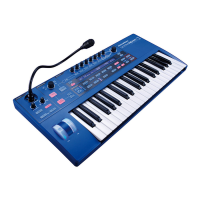
